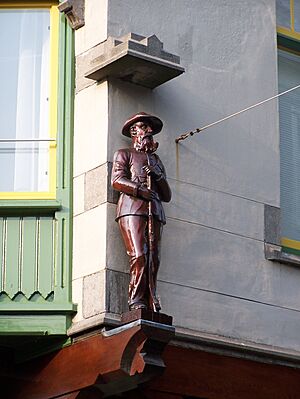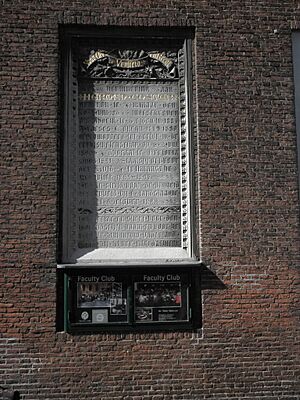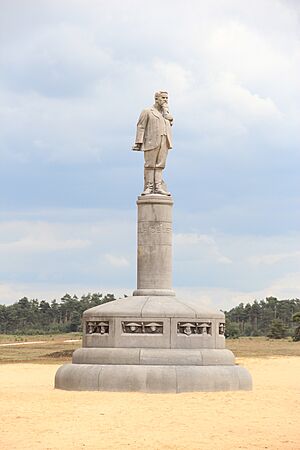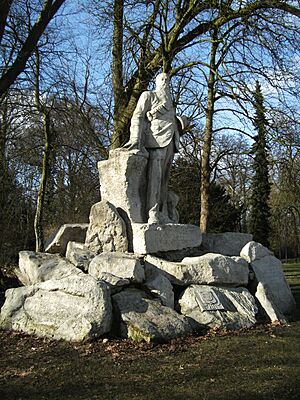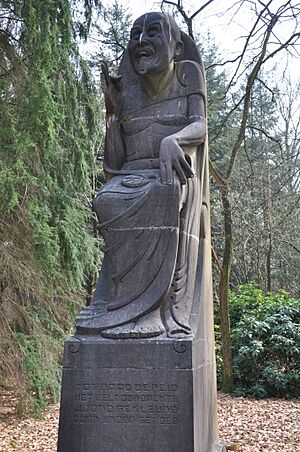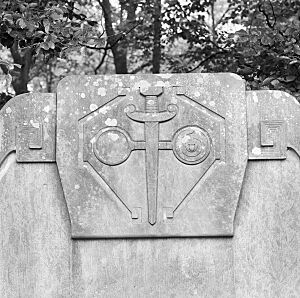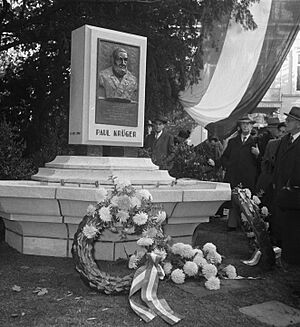List of Second Boer War Monuments in the Netherlands facts for kids
The Second Boer War was a major conflict in South Africa that happened between 1899 and 1902. It was fought between two independent states, the Orange Free State and the South African Republic (also known as the Transvaal), and the powerful British Empire. The British eventually won the war.
During this time, the Netherlands strongly supported the Boers. About 2,000 Dutch volunteers even traveled to South Africa to fight alongside them. This support came from the close ties between the Dutch and the Afrikaners (also called the Boers). Most Afrikaners were descendants of early Dutch colonists in South Africa.
After the Second Boer War, many monuments were built in the Netherlands. These monuments remember the war and the people involved.
Contents
Remembering the Boer War in the Netherlands
The people of the Netherlands felt a strong connection to the Boers in South Africa. This was because many Boers had Dutch ancestors. To show their support and remember the war, many streets, neighborhoods, and even districts in the Netherlands were named after important Boer leaders. This started in 1899 and continues today.
Famous Boer leaders like presidents Paul Kruger and Martinus Theunis Steyn, and generals Louis Botha, Koos de la Rey, and Christiaan de Wet visited the Netherlands. Their visits helped inspire these names. Even Jan Smuts, who later became prime minister of the Union of South Africa, visited in 1948.
The Transvaal Boer in Amsterdam
- Year: 1900
- Location: Gasthuismolensteeg 20, Amsterdam
- About: This monument is called De Transvaalsche Boer (The Transvaal Boer). It honors the South African Republic. In 1900, a building on Gasthuismolensteeg was renovated. A cigar shop named De Transvaalsche Boer opened there. A small statue of a Transvaal Boer, made by Johann Zeitz, was added to the building. It was put there to remember the war.
Boer Leaders in Gouda
- Year: 1901
- Location: Blekerssingel, Gouda
- About: On the "Wapen van Amsterdam" residences, you can see four portraits of Boer leaders. These leaders were from the Orange Free State and the South African Republic. The portraits show Marthinus Theunis Steyn, who was president of the Orange Free State. Also shown are Piet Retief, a famous Voortrekker leader, and Paul Kruger, president of the South African Republic. General Petrus Jacobus Joubert is also depicted. These sculptures were created by Christiaan Petrus Clemens. They are placed above the windows and doors of three houses.
Herman Coster Plaque in Leiden
- Year: 1901
- Location: Academiegebouw, Leiden
- About: At the entrance of the Academiegebouw, part of Leiden University, there is a special plaque. It remembers Herman Coster, who was a student there. Coster died in the Battle of Elandslaagte in 1899 during the war. He served as a state's advocate for the South African Republic from 1895 to 1897.
Christiaan de Wet Statue
- Year: 1921
- Location: Otterlose Zand, Hoge Veluwe National Park
- About: This statue honors Christiaan de Wet. He was a general and the seventh and last president of the Orange Free State. The statue was made by Joseph Mendes da Costa. It was ordered by Helene Kröller-Müller. The base of the statue also shows other Boer soldiers.
Marthinus Theunis Steyn Monument
- Year: 1922
- Location: Rijsterborgherpark, Deventer
- About: This monument is dedicated to Marthinus Theunis Steyn. He was the sixth president of the Orange Free State. This monument became a significant spot for protests against apartheid in South Africa between 1960 and 1990.
De Raadsman (The Advisor)
- Year: 1920-1924
- Location: Jachthuis Sint-Hubertus, Hoge Veluwe National Park
- About: This sculpture, called De Raadsman (The Advisor), was made by Joseph Mendes da Costa. It honors Marthinus Theunis Steyn, the sixth president of the Orange Free State. Helene Kröller-Müller, who commissioned the statue, did not think the design was suitable to be given to South Africa.
President Steyn Bench
- Year: 1923-1924
- Location: Hoge Veluwe National Park
- About: This bench is known as the President Steyn bench. It also honors the Orange Free State.
Paul Kruger Monument
- Year: 1952
- Location: Formerly Buitenplaats Oranjelust, Maliebaan 89, Utrecht
- About: This monument is dedicated to Paul Kruger, who was the fifth president of the South African Republic. It was designed by Isabella van Beeck Calkoen. This is believed to be the only monument of Paul Kruger in the Netherlands. In 2011, the monument was reported to be in poor condition. The building number is on top of the decorative band (frieze) of Paul Kruger.


